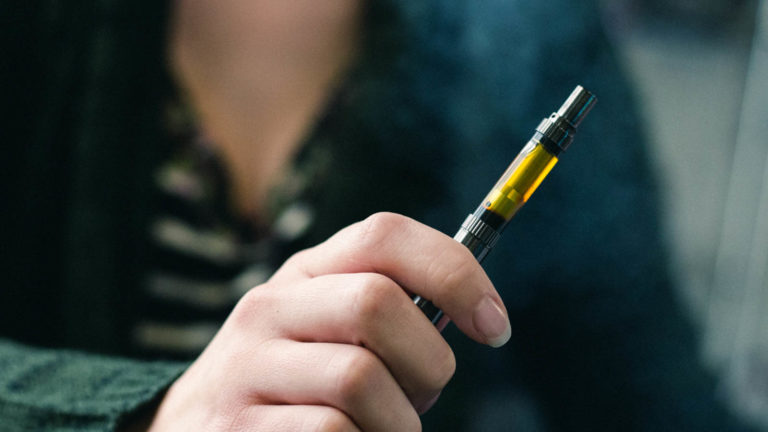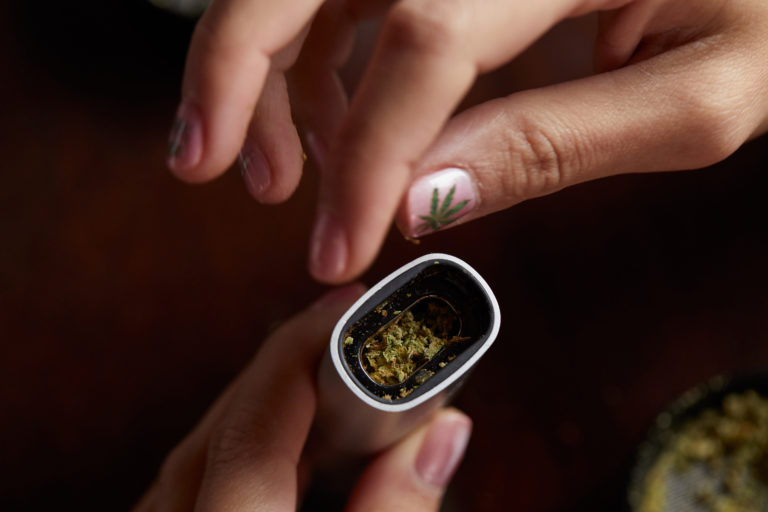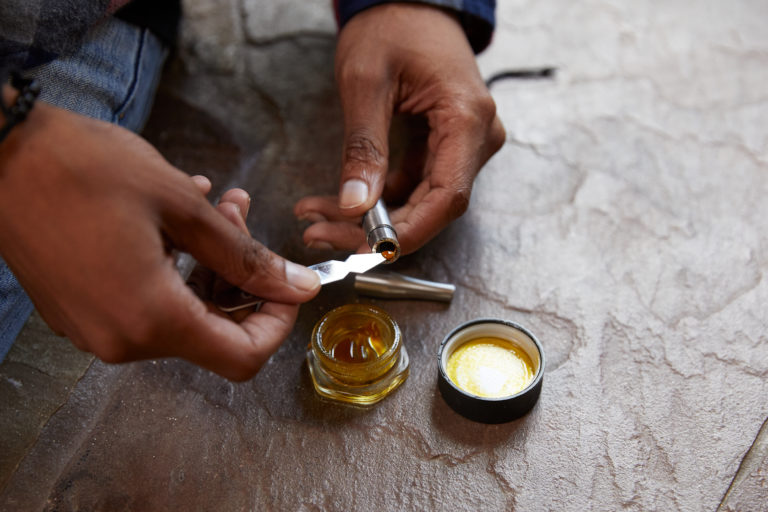To inhale and exhale vapor with the use of a vaporizer, electronic cigarette, dab rig, e-nail, vape pen (sometimes referred to as a weed pen), or similar device. These devices utilize a heating element to quickly vaporize the active ingredients in cannabis for smooth, non-combusting consumption. Vaporization also allows people who require stronger medical cannabis products safer access to higher-potency cannabis through the use of concentrates and extracts.
I can really taste the flavors of Jet Fuel when I vape it.
Enjoy your herb to the fullest and vape out of a Volcano.
 Photo by: Gina Coleman/Weedmaps
Photo by: Gina Coleman/WeedmapsImage lightbox

What does it mean to vape or use a vape?
Vaporizers have been around longer than you would believe.
When someone refers to a “vape” or “vaping,” they're describing the act of vaporization, which consists of inhaling and exhaling aerosols, commonly called vapor, produced from an e-cigarette or vaporizer device.
Vaping is popular among consumers because it offers a smokeless way to enjoy tobacco or cannabis. Rather than inhaling and exhaling combusted plant material, the e-cig preserves the flavors and produces vapor, not smoke.
Why would anyone want to vape cannabis instead of burning it? Smoking any plant material requires burning it. Studies have shown combustion of plant material introduces airborne and skin-borne carcinogens into the body. When cannabis is heated to a certain point, the desired cannabinoids are released without igniting the plant material, making vaporizers a preferred method to those who want to avoid smoking.
While there are various vaporizers available on the market today, vape pens, direct-draw vaporizers, and disposable vape pens, are among the most common and accessible devices for vaping. Vape pens are shaped like a writing pen, and utilize conduction heating that works directly in contact with cannabis flower or concentrate. The electronically heated screen or metal surface is designed to heat the herb or concentrate to a precise temperature and burn it evenly. Uneven heat distribution can combust the flower or concentrate, which means you're actually smoking, not vaping.
Why do people prefer vaping?
While many cannabis connoisseurs will argue that there's no better method of consuming cannabis than the traditional lighting and smoking of a joint, pipe, or bong, consumer preferences are changing.
So why do consumers vape? There is evidence that vaping maximizes terpene flavors and cannabinoid intake. Vaping also reduces the risk of exposure to harmful chemicals created during the process of smoking.
The Journal of Cannabis Therapies conducted a study in 2004 designed to evaluate the effectiveness of the Volcano herbal vaporizer by comparing what happens when cannabis was vaporized with what happens when it was combusted, or smoked.
The study found that vaporization is an effective method for delivering medically active cannabinoids while suppressing other potentially harmful compounds that are a byproduct of combustion.
More effective delivery of cannabinoids
Vapes can provide a safe solution for medical marijuana patients with weakened respiratory systems. Patients who medicate with vaporizers are more likely to receive increased medicated effects. By inhaling the vapor through a vaporizer, the lungs are less likely to be irritated as well. A clinical trial published in 2010 in the International Journal on Drug Policy tested 20 cannabis users; of that group, 12 participants who did not develop a respiratory illness during the trial showed significantly reduced respiratory symptoms.
Flavor saver
The key to a smooth and flavorful experience depends on temperature. Some vaporizers have preset temperatures, while others have dials that allow the cannabis to be heated to a desired temperature, releasing the essence of the cannabis flower.
Discretion
Vaping leaves a discreet trail of vapor after each use that dissipates quickly. Portable vaporizers allow consumers to toke on the go without offending others with the sight and odor typically left after smoking marijuana flower. However, some vape brands use natural terpenes to flavor cannabis concentrates, leaving behind a slight cannabis aroma. Moreover, the vape pen itself has a compact design and is easily transportable, adding to the convenience and discretion that the vaporization process provides.
Are there any risks to vaping?
Yes. Much is still unknown about the long-term effects of cutting agents commonly used in vape cartridges. The four most widely used are polyethylene glycol (PEG), propylene glycol (PG), vegetable glycerin (VG), and medium-chain triglycerides (MCT). These cutting agents are sometimes added to the cannabis oil to improve vapor quality and overall mouthfeel.
A 2017 study published in the Journal of Alternative and Complementary Medicine, “Carbonyl Compounds Produced by Vaporizing Cannabis Oil Thinning Agents,” tested polyethylene glycol 400 (PEG 400), PG, VG, and MCT. Researchers found that when inhaled, PEG 400 produced significantly higher levels of acetaldehyde and formaldehyde when vaporized than PG, VG or MCT. Formaldehyde production in PG was significantly higher than that of VG or MCT.
Additionally, vaping is not allowed in many public spaces. In many states, landlords and employers can also place restrictions on vaping and smoking on the premises.
How to vape
Oil
Cannabis oil comes in the form of a syringe, e-liquid, or pre-filled cartridge. Consumers who use syringes can vaporize the product in a dab rig or fill an empty cartridge tank for use with a 510-thread battery. Pre-filled cartridges are easy and convenient. Simply screw the cartridge on to the battery and it's ready to go.
 Photo by: Gina Coleman/Weedmaps
Photo by: Gina Coleman/WeedmapsImage lightbox

Flower
Vaporizing dry flower requires a vaping device with special temperature settings that maintain an optimal temperature range between 365-375 degrees Fahrenheit, or 185-190 degrees Celsius. The cannabis flower should have an even tobacco-brown burn after it has been vaporized. There are a variety of portable dry-herb vaporizer and stationary devices on the market, so the first consideration to make is if you want a device that can be used on the go or just for home use.
 Photo by: Gina Coleman/Weedmaps
Photo by: Gina Coleman/WeedmapsImage lightbox

The airflow in dry-herb pens allows fresh air to flow over the coil to your mouth, preventing the coil from overheating. Some vape pens have a ring that allows users to adjust the airflow as needed.
Dry-herb vape pens vaporize coarsely grated cannabis flower that has been milled through a grinder. The material is packed into the chamber of the weed pen after you've adjusted the temperature settings. Not all vape devices are created equal — it is always best to read the instructions before use to ensure you get the optimal vaping experience.
Concentrate
Aside from pre-filled cannabis oil cartridges, another way to vaporize cannabis concentrates is by using a dab pen, also sometimes referred to as a wax vaporizer. What is a dab pen and how does it differ from a conventional vape pen? Although inner mechanics are similar, the distinguishing factor is how the concentrate is consumed. A vape pen utilizes a pre-filled cartridge, while a dab pen allows consumers to load their own cannabis concentrates into the chamber of the vaporizer.
 Photo by: Gina Coleman/Weedmaps
Photo by: Gina Coleman/WeedmapsImage lightbox

The history of vaping
Many civilizations have vaporized herbs for thousands of years. The first documented account of vaporizing occurred in Egypt around the 5th century BC, when ancient Egyptians experimented by heating oils on large, hot stones. The trend then spread into Afghanistan, and eventually circulated around the globe.
Egyptians and the hookah
From a product standpoint, the first vaporizer was the hookah, also called shisa, invented more than 15,000 years ago by Irfan Shaikh of the Safavid Dynasty of what is present-day Afghanistan. The dynasty later introduced this method to India. Hookah, called ḡalyān in Persian culture, today is used most commonly with tobacco products.
Modern vaping
The first design of the e-cig carried a heavy battery attachment that offered more power, but at the cost of added weight, while contemporary vape devices boast an improved look that offers both modernization and efficiency.
In 1927, Joseph Robinson came up with the idea of the electronic cigarette and filed a patent from the United States Patent and Trademark Office (USPTO) for the first mechanical butane ignition vaporizer. His patent was issued three years later.
In 1960, Herbert A. Gilbert, an American veteran of the Korean War, built the first e-cigarette. The original prototype is still widely used as the basis for today's e-cigarette companies.
In Amsterdam, Eagle Bill Amato, deemed the father of the cannabis vaporizer, drew a following for popularizing the devices. He called his device a “safe and effective alternative to smoking.” He named the device the Eagle Bill Shake & Vape after himself, of course.
In 1994, BC Vaporizer in Canada invented an electronically charged vaporizer inspired by Amato's design, while the 2000s brought the invention of the desktop vaporizer. One of the most recognizable is the Volcano, a desktop device that allows users to fill a bag with vapor and inhale as needed. Other popular desktop vaporizers are square, modular units with a tube connected to a mouthpiece.
Vaporizers have taken many shapes over the years, but one thing remains the same: Some people see value in avoiding combustion and opt to vaporize their cannabis. As long as there is demand, manufacturers will continue introducing innovative products to meet people's needs.
How much is a vape pen or vaporizer?
The price of a vape pen or THC vape juice will depend on several factors, including the market it's being sold in, the amount of distillate in the cartridge (typically either a half-gram or a full gram), the quality of both the cannabis oil and vaporization device, as well as if the device is disposable or reusable. You should also take certain characteristics of the battery into account when selecting a vape pen. The device's overall heat-up time and amount of vapor production will be dictated by the continuous discharge rating (CDR) and voltage output. If you want a vape pen that will remain functional without the constant need to recharge it, look for something with a high battery capacity.
Options vary from cheap stand-alone batteries to starter kits that provide a battery charger, refillable vape cartridges, and additional tools to help maintain the vape pen. More importantly, you should always strive to buy vape products from reputable brands that provide a certificate of analysis from a third-party testing lab.
Frequently asked questions
How long does it take for you to feel the effects of your vape?
It depends on your vaping method, but both vape pens and dry flower vaporizers typically begin to produce effects within minutes of consumption. Feeling the full effects of a vape pen or vaporized flower may take a bit longer, possibly 10–15 minutes. The most important factor to keep in mind anytime you're talking about the onset time of cannabis effects is that everyone's body is different, and will therefore react to cannabis differently.
How do you know weed is done after vaporizing?
Once your vaporized weed has gone from green to dark brown in color, most of its cannabinoids have been activated and its potential effects will be significantly diminished. If your vaped bud has turned black, it was likely vaped for too long or at too high a temperature.
Can you smoke weed after it's vaporized?
Yes, you can smoke weed that has already been through a vaporizer, but the smell and flavor of the bud, as well as the high it produces, will be degraded. If your vaped weed is light to dark brown, it may have some THC and other cannabinoids left to produce a high, but the deteriorated smell, flavor, and effect may not be worth the hassle.

